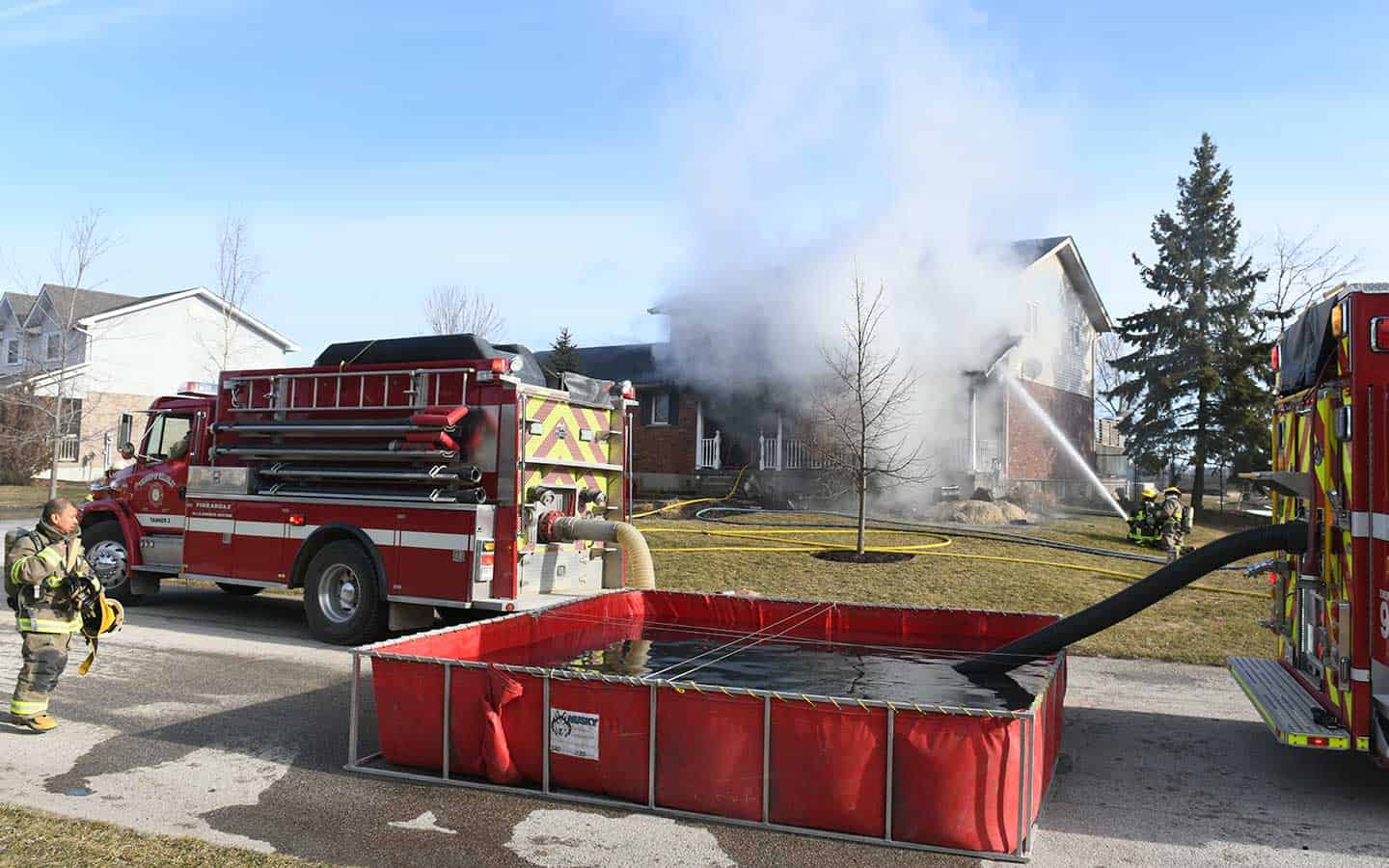Hundreds of students from Elmira District Secondary School staged a walkout of classrooms last week as part of province-wide demonstrations against the Ford government’s proposed changes to education.
Taking to the streets of Elmira an hour before the end of school on April 4, the EDSS students voiced their opposition to the changes, which would see average classroom sizes increased in Ontario high schools from 22 to 28 students per teacher, as well as cuts to student loan programs.
From the school, the students marched up Arthur Street for impromptu demonstrations outside the office of Kitchener-Conestoga MPP Mike Harris.
“We say no!” chanted the large crowd, who waved signs at passing motorists as they made their way up the street in an orderly fashion.
“What I personally want to do with this walkout is get information out there and let the public know that students have an opinion,” said EDSS student Mariah Martin, one of the organizers of the demonstrations. “We’re not just going to lay back and let whatever’s happening happen to us. We want to let the public know that we don’t support it, or at least some of us, and make a stand for what we need in our education and our future.”
Premier Doug Ford was quick to dismiss the protests as provoked by the teachers’ unions. The local MPP, however, struck a more conciliatory note.
“The first thing to realize here is that I fully support students out voicing their opinion. We’re happy to chat when we’ve got time available, and we certainly want to listen to the concerns that they have,” said Harris in an interview. “I give students full credit if they’re coming to these conclusions from their evaluation of what’s going on.”
A father of five himself, Harris said he had a vested interest in creating the best education system possible for students.
“I want them to make sure that they’re in safe, supportive classrooms. I want to make sure that we’re meeting standards when we talk about educational testing. I want to make sure that our government’s putting our best foot forward when it comes to helping our kids succeed, and I think we’re on the right track to doing that.”
The Ford government has said larger classroom sizes, as well as compulsory e-learning courses for high school students, would help prepare students for the future. However, students and educators say the province is being driven by an austerity agenda, and looking for savings at the expense of public education.
Ford was elected on a promise to balance Ontario’s budget, which the PC government estimates will see a $13.5-billion deficit this year. Ontario’s debt, meanwhile, is being estimated at $346 billion by the Ontario Financing Authority for 2018-19, with interest payments on the debt alone expected to cost $12.5 billion, the third-largest expenditure after health care and education.
“The fact is that we’ve been left by the Liberals with a pretty big financial mess,” said Harris. “So there are definitely some tough choices that have to be made. But in making those tough choices, we still want to make sure we are providing students with the necessary skills that they need to become part of the workforce later in life.”
Whether these tough choices will means cuts to education spending is not something Harris could elaborate on, he said, until after the release of the Ford government’s budget on Thursday (April 11). But the province has said that no teachers will lose their jobs as a result of the increase in class sizes, which will be phased in over four years through attrition.
“We will not be laying off any frontline workers. Any efficiencies that are being found are going to be positions where people are retiring,” said Harris.
With the PC government making math, science, literacy and skilled trades its focus in education, students worry that fewer teachers will mean a reduction in extracurricular activities, and a de facto defunding of the arts.
While classroom sizes will be increased in the coming years, Ontario autism advocates have also raised a red flag over the province’s changes to autism assistance, which they say will see more students with special needs joining regular classrooms. The plan decreased funding to children with autism based on age, and uses a flat-rate funding model children with autism.
The province has argued the new model will clear more children off the wait list for assistance, but the changes were bitterly opposed by many in the province.

After backlash to the initial plan, including protests outside the MPP’s Elmira office in February, the government announced “enhancements” to the Ontario Autism Program (OAP) last month, and has said it intends to launch public consultations in May.
“On the OAP side of things, we’re doubling – well actually I think we’re more than doubling the investment into the OAP program, up to $600 million now,” said Harris. The Ontario Autism Coalition has said the enhancements do not address the primary concerns of autism stakeholders.
“We’re looking into all of these things, we’re going through a consultation period right now where we’re meeting with stakeholders, we’re meeting with school boards, we’re meeting with the teachers unions,” said Harris.
Cutbacks to the Ontario Student Assistance Program (OSAP) formed another major flashpoint for the EDSS protesters, with the province scrapping the free tuition scheme of the previous Liberal government for low-income students. The income bracket for families eligible to receive OSAP was also decreased from $175,000 to $140,000, while the six-month interest free grace period for graduating students to pay back their loans was eliminated.
With the province moving forward on its austerity agenda, more belt cinching is likely ahead for Ontarians as the government tries to rein in spending without raising taxes, another promise of the Conservative government.
Asked if these program changes would disproportionately affect Ontario’s most-vulnerable, Harris points out that the province needed to move back to operating sustainably.
Spending proposed in 2018-19 by the defeated Liberal party would have seen Ontario’s deficit, and debt, continue to grow.
“A lot of the programs you’re talking about have become so unsustainable under the previous government, that a lot of these programs were actually going to run out of money,” said Harris. “And when you talk about making sure that these programs are there for vulnerable people in the future, there’s some real changes that need to be made.”
EDSS students, however, urged the government to find a better solution.
“I would just say: find another way,” said Garret Tracey, a fifth-year student at EDSS participating in the protest. “I know the biggest reason a lot of these cuts are being made is because Ontario is in a debt, and I will concede that debt does need to be paid off. But there’s got to be another way than at the expense of our students’ future.”
See previous story with photo gallery HERE









